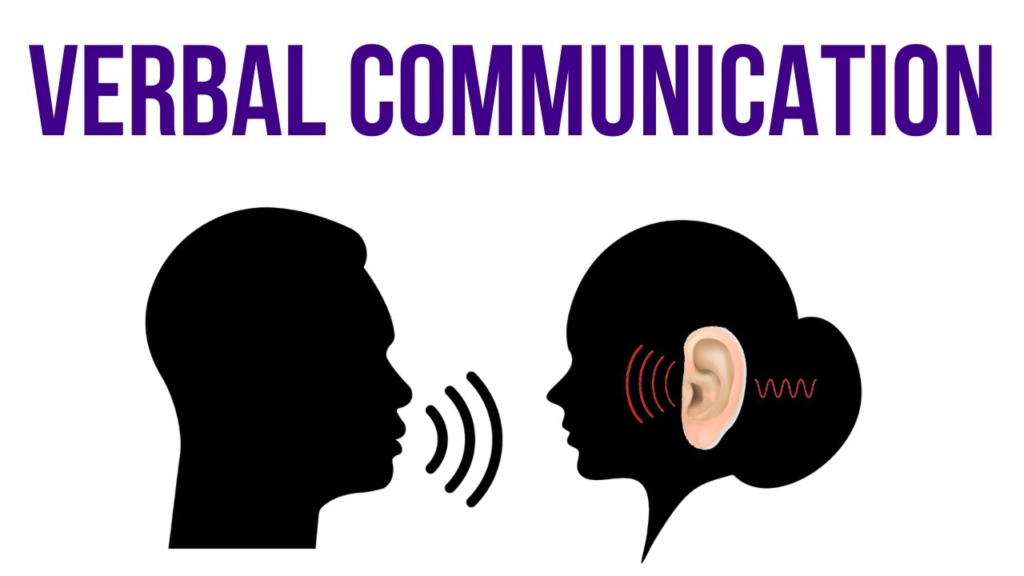There are four types of Communication :

(1) Verbal communication
(2) Non-verbal Communication
(3) Written Communication
(4) Visual Communication
(1) Verbal communication:-

When we speak or say something, we are communicating much more than just the content of our words. It can be face-to-face or through electronics means(like phone or video calls).
The thing that is used in verbal communication is “Oral”, which means that we can communicate through speak. It is the most common and popular mode of communication. It is divided into formal and informal.
Ex.- conversations, phone calls, presentations, speeches.
When we talk about Formal, it means we follow specific rules and regulations, protocols. It is often used in professionals or institutional, like- communicate with the boss in the office, the way to talk to the principal etc.
But in the informal communication, we don’t follow any rules, protocols. It is typically unplanned and occurs in personal or casual contexts.
Ex.- Talking with friends, family members etc.
The term “Pitch”- The point pitch is very important, because when we speak, our emotions can often come into play. If we are angry, frustrate our pitch might raise, moving to the listener that we are experiencing a strong emotion.
Tone- We all encounter situations that are frustrating or upsetting. Allowing that to change our tone from calm and professional to short or rude is always a mistake.
(2) Non-verbal Communication:-
There is no exchange of words in this communication. We only interact with signs and symbols. Non verbal leads often complement verbal communication.

For example:- we all have heard an unprofessional comment and raised our eyebrows in response.
There are many types in non verbal communication:-
[1] Facial Expressions:- We often use facial expressions as a way to communicate that we are listening and engaged with the person speaking. A smile or a quizzical expression all convey information to the speaker that we are responding.
[2] Gesture:- The movements we make with our hands, head or face are termed as a gesture. It depends on the person and their country of origin, they may use gestures and physical touch a lot, or almost never. However, there is a lot of information communicated in these actions.
[3] Eye Contact:- We all know the importance of eye contact, being able to maintain eye contact while listening will ensure that the speaker knows that you are present and engaged, if we unable maintain eye contact, it means that they are being dishonest, untruthful or not paying attention.
[4] Posture:- Posture refers to the body language, if you angle yourself towards the person, with a relaxed and open posture, you invite them to engage with you happily.
Crossing arms, leaning back or turning away from the speaker, it is not a positive one.
(3) Writing Communication:-

When opinions are exchanged in written form, rather than by spoken words. It may be expressed through pictures, charts, diagrams, newspapers, letters, emails, etc. while using written communication, words should be selected very carefully because the message one sent cannot be altered.
Structure in the writing communication is very important because it thinks about how we are presenting the information using paragraphs and line breaks are necessary.
Clarity, when we message any person it is hard to strike between over or under explaining concepts that the person gets the instructions or messages.
In the writing communication, content also matters because written content tends to be a bit more formal than verbal. We should use proper punctuation and spelling, and remember that anything written especially in the digital age will remain, even if we delete it.
(4) Visual Communication:-

Visual has become the most used type of communication, driven by social media, YouTube and other platforms of the digital era. In this era, as more as people and organizations use these channels of communication, the more we are used to, and even dependent upon. We rely heavily on visual communications. Uses visual elements to communicate information. It often accompanies other forms of communication to clarify or emphasize a message.
There are many ways that visual communication, like photos, videos, sketches, graphs and now even emojis and GIFs, can help improve the understanding of our messages.

Source- Google
Written by Rajat Ranjan
